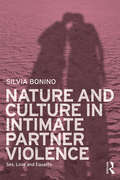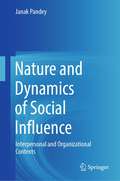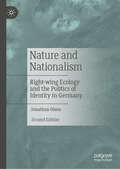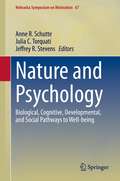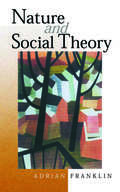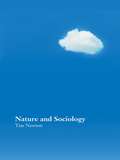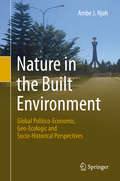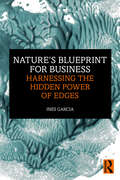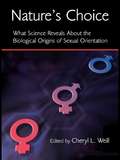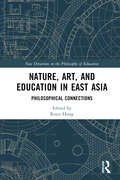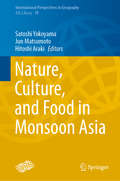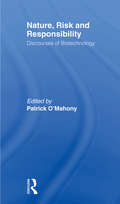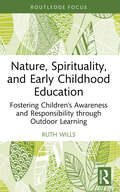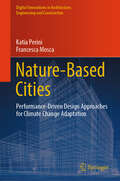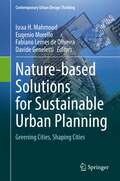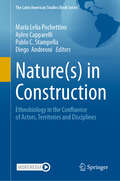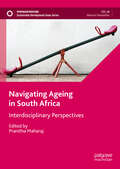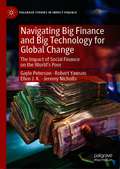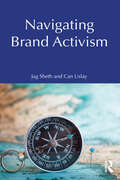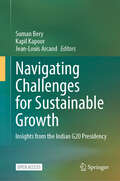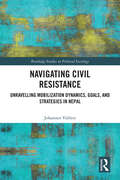- Table View
- List View
Nature and Culture in Intimate Partner Violence: Sex, Love and Equality
by Silvia BoninoThis innovative book aims to further our understanding of violence in intimate relationships between men and women by combining research from psychology, cultural studies, and biology. The author examines why western culture often justifies and encourages primitive forms of relationships based on domination and submission and considers not only the cultural influences, but also the biological aspects, in their interaction. The book clarifies the biological roots of aggression and affection in intimate relationships in humans, showing that considering the biological roots of male dominance on women does not imply any justification. Bonino makes the case that awareness about the biological roots of violence, and about the cultural messages supporting them, is necessary for developing different messages and educational practices promoting human capacity of personal affective relationship, where partners empathically recognize themselves as equal human beings. Relationships are examined in relation to a domination/submission framework, with the author emphasizing the role individuals can play in promoting non-aggressive relationships. By examining aggressive behaviour in relation to cultural, social psychological, and biological ideas, the author seeks to clarify the cause of violence in relation to gendered roles. This is fascinating reading for anyone interested in violence in relationships and suitable for students and academics in psychology and the social sciences.
Nature and Dynamics of Social Influence: Interpersonal and Organizational Contexts
by Janak PandeyThe book presents the various ways in which persuasion can be used to make people behave in certain ways without coercion, intimidation, or brute force. It explores the intricacies of social influence processes like self-presentation, impression management, ingratiation, persuasion, manipulative social behavior, and compliance in socio-cultural contexts. Social influence constitutes one of the key themes in the field of social psychology. Contributions in the book highlight social influence behavior and its importance in human social life. The book deepens the reader's understanding of social psychology research on the science and applications of social influence. It invites readers to consider critical questions, such as the interactive effects of personality/disposition and situational factors on social influence. Given its scope, the book is of interest to those in academic fields like social psychology, political science, mass communication, and marketing.
Nature and Nationalism: Right-wing Ecology and the Politics of Identity in Germany
by Jonathan OlsenIn this new edition of his now classic 1999 book, Jonathan Olsen explores the relationship between the far right and the environment, or what he terms “right-wing ecology.” Arguing that radical environmentalism is not exclusively a domain of the left, Olsen shows how many of Germany's far right parties and groups ground their ecological ideology in an anti-universalist anthropology which sees human beings as naturally 'rooted' in specific nations and cultural traditions. Pollution in this discourse signifies not only the disruption of the natural world, but the social world as well, thus providing an environmental justification for an anti-immigrant politics which finds resonance outside the specific milieu of the far right. A rigorously theoretical book, Nature and Nationalism challenges our understanding of the deeply ambiguous ways in which 'nature' functions to legitimate a wide variety of political ideas.
Nature and Psychology: Biological, Cognitive, Developmental, and Social Pathways to Well-being (Nebraska Symposium on Motivation #67)
by Jeffrey R. Stevens Anne R. Schutte Julia C. TorquatiThis volume is comprised of contributions to the 67th Nebraska Symposium on Motivation, which brought together various research disciplines such as psychology, education, health sciences, natural resources, environmental studies to investigate the ways in which nature influences cognition, health, human behavior, and well-being. The symposium is positioned to explore two proposed mechanisms in the most depth: 1) the psycho-evolutionary theory of stress recovery and 2) Attention Restoration Theory. The contributions in the volume represent research guided by both of these posited mechanisms, rigorously examine these theories and processes, and share methodological innovations that can be utilized across programs of research. This volume will be of great interest to researchers on natural environments, practitioners and clinicians working with an environmental lens at the intersection of psychology, social work, education and the health sciences, as well as researchers and students in environmental and conservation psychology. Chapter 5 is available open access under a Creative Commons Attribution 4.0 International License via link.springer.com.
Nature and Social Theory
by Adrian Franklin`Written with clarity and sophistication, it is not just an original argument about relationships of nature and culture, but also a useful text' - Keith Tester, Professor of Sociology, University of Portsmouth Is humanity and society separable from nature? Modern accounts emphasised the difference between humanity and nature and set up independent sciences for each domain, but was this separation ever properly achieved? This book contends that fabricated boundaries between nature and culture have been breached both in practice and in new theoretical accounts. Throughout, Franklin develops upon his premise that nature and culture interpenetrate. The argument begins with a critical discussion of the Romantic idea of pure nature; of a nature unsullied by humanity, marginalized, fragile and in need of protection. The argument is developed by examining more recent discourses that identify nature with environment, and cast humans in the role of polluter and destroyer. The author documents contemporary views about nature which suggest that humanity and nature have never been separate but have always co-existed. Humanity is not only more involved with non-human natures, but also seeks persistently to embed itself in the natural world through embodied, naturalised modes of engagement. This book reveals the staggering depth of this engagement in the ordinary spaces and everyday lives of contemporary societies. Thorough and insightful, this book will be of use and interest to students of sociology, environmental studies and cultural studies.
Nature and Sociology
by Tim NewtonThis book engages with, and contests, the ‘new sociology of nature’. It moves beyond existing debates by presenting new social theory and working across current fields of interest, addressing the debate on new genetics and genomics, taking human biology seriously, and the issues of interdisciplinarity that are likely to arise in longer term attempts to work across the social and natural world. Nature and Sociology will be of great interest to students of a variety of disciplines including sociology and social science, human geography, social and biological anthropology, and the natural sciences.
Nature and the Environment in Amish Life (Young Center Books in Anabaptist and Pietist Studies)
by David L. McConnell Marilyn D. LovelessThe Amish relationship to the environment is much more complicated than you might think.The pastoral image of Amish communities living simply and in touch with the land strikes a deep chord with many Americans. Environmentalists have lauded the Amish as iconic models for a way of life that is local, self-sufficient, and in harmony with nature. But the Amish themselves do not always embrace their ecological reputation, and critics have long questioned the portrayal of the Amish as models of environmental stewardship.In Nature and the Environment in Amish Life, David L. McConnell and Marilyn D. Loveless examine how this prevailing notion of the environmentally conscious Amish fits with the changing realities of their lives. Drawing on 150 interviews conducted over the course of 7 years, as well as a survey of household resource use among Amish and non-Amish people, they explore how the Amish understand nature in their daily lives and how their actions impact the natural world. Arguing that there is considerable diversity in Amish engagements with nature at home, at school, at work, and outdoors, McConnell and Loveless show how the Amish response to regional and global environmental issues, such as watershed pollution and climate change, reveals their deep skepticism of environmentalists. They also demonstrate that Amish households are not uniformly lower in resource use compared to their rural, non-Amish neighbors, though aspects of their home economy are relatively self-sufficient.The first comprehensive study of Amish understandings of the natural world, this compelling book complicates the image of the Amish and provides a more realistic understanding of the Amish relationship with the environment.
Nature in the Built Environment: Global Politico-Economic, Geo-Ecologic and Socio-Historical Perspectives
by Ambe J. NjohA good understanding of the status quo is necessary for the success of efforts to develop and maintain nature in built space. Accordingly, this book conducts an environmental scan of the context of these efforts in global perspective. In particular, it develops and employs a novel environmental scanning model (ESM) designed to rigorously analyze the political, economic, social, technological, ecological, cultural and historical (PESTECH) contexts of initiatives to promote biodiversity in the built environment. The focus is on four specific substantive areas of environmental policy, namely forestry, water, food, and energy. The units of analysis roughly correspond with the major United Nations Environmental Programme (UNEP) regions of the world, including sub-Saharan Africa, Middle-East and North Africa, Asia and the Pacific, Western Europe, North America, and Latin America and the Caribbean.
Nature's Blueprint for Business: Harnessing the Hidden Power of Edges
by Ines GarciaTapping into proven strategies, mechanisms and patterns that have been fine-tuned over 3.8 billion years, this book bridges the gap between the natural world and the business world and explores how to develop resilient organizations and businesses using lessons from nature.The science of biomimicry is an emerging force in helping us to gaze afresh at the world around us, often inspiring technological inspiration, but we have been slow to look at the organizational and relationship models that are all around us. This book contends that natural abundance flourishes at the edges, where one environmental element contacts another, and that these relationships that have been successful for millennia have endless lessons for us about how we organize ourselves. Each chapter starts with a clear example of a problem that a team or organization might face, goes on to consider a range of natural examples and offer practical suggestions to incorporate nature’s wisdom in the business world, and concludes with success stories of people and organizations already embracing the principles outlined in the book. Employing these principles and aided by suggested activities, readers will develop personalized plans, tailored to their unique situations, to lead their teams’ evolution into thriving organizations.Observing edges, spaces and boundaries shows that is these are where magic happens—and with this book, leaders of all types of teams and organizations will be empowered to make real and immediate changes in their own contexts.
Nature's Choice: What Science Reveals About the Biological Origins of Sexual Orientation
by Cheryl L. WeillThe true role of biology in determining sexual orientation is an oft-debated issue in both the popular media and scientific communities, and evaluating the literature on the topic can be daunting. Nature’s Choice: What Science Reveals About the Biological Origins of Sexual Orientation offers both a comprehensive review of the scientific literature and a fresh perspective on this complex and politically charged subject. Respected researcher, speaker, and author Dr. Cheryl Weill offers readers of all backgrounds an enlightening analysis of findings from over twenty years of research on the factor of biology in the determination of sexual orientation. Nature’s Choice: What Science Reveals About the Biological Origins of Sexual Orientation brilliantly distills complicated studies and research findings dealing with brain anatomy, genetics, sex-typical behavior in children, auditory, startle reflex, and many other areas. Spanning a wide range of important topics including human sexual development and the effects of hormones, Ellis and Ames’ Gestational Neurohormonal Theory, the ins, outs, and implications of how scientific research is funded, and model of the role of testosterone in determining human sexuality, Nature’s Choice: What Science Reveals About the Biological Origins of Sexual Orientation is an exciting book to educate and inspire readers from scientific and non-scientific backgrounds equally.
Nature, Art, and Education in East Asia: Philosophical Connections (New Directions in the Philosophy of Education)
by Ruyu HungThis volume explores the deeply interwoven connection of education, art and nature in the context of East Asia. With contributions from authors in South Korea, Japan and Taiwan, the book considers unnoticed but significant themes involved in the interplay of nature, art, and education. It manifests how nature and art can educate, and how education and nature play the role of art. The chapters explore a range of themes relevant to East Asian characteristics, including skill acquisition, Japanese calendar arts and ritual of feelings, garden architecture, the ritualised body, collaborative poetry art, translational language between humans and nature, the Confucian classical Six Arts, the artistic embodiment of the Kyoto School, and the heritage art based education in Korea. The authors examine these themes in novel ways to bring to light the relevance of the East Asian insights to the contemporary global world. This book is an outstanding resource to all researchers, scholars, and students interested in educational aesthetics, philosophy of education, East Asian studies, comparative education and intercultural education.
Nature, Culture, and Food in Monsoon Asia (International Perspectives in Geography #10)
by Satoshi Yokoyama Jun Matsumoto Hitoshi ArakiThe giant Asian monsoon has formed a diverse climate and natural environment. The Asian monsoon climate manifests itself in manifold ways depending not just on the latitude or altitude of an area but also on physical conditions such as topography and vegetation and even the size of its human population. Likewise, the livelihoods of people in the affected area are diverse. This book focuses on nature and agriculture, food, and climate and culture as an excellent framework for understanding the relationship between humans and the environment in complex Monsoon Asia. Through the discussions in this book, what the authors have sought to demonstrate is that the livelihoods in Monsoon Asia demonstrate unique forms in a limited environment, while the Asian monsoon climate has one of the largest movements of any natural phenomenon on a macroscopic scale. These manifest forms are diverse both on a time scale and on a spatial scale and are extremely diversified in limited regions. Such diversity is not only due just to the effects of the natural environment but also results from social and cultural forces. In this area of Monsoon Asia, traditional and religious social norms are becoming entangled with “new” economic and political norms brought in from the outside world by globalization.
Nature, Risk and Responsibility: Discourses of Biotechnology
by Patrick O'MahonyThis book explores ethical interpretations of biotechnology and examines whether sufficient consensus exists or is emerging to enable this technology to occupy a stable role in the techno-economic, social, and cultural order. It employs a wide range of social theories to evaluate risks.
Nature, Spirituality, and Early Childhood Education: Fostering Children’s Awareness and Responsibility through Outdoor Learning (Routledge Research in Early Childhood Education)
by Ruth WillsThis novel volume delves into a specific and crucial aspect of early years pedagogy – the intersection between early childhood education and spirituality, offering tips on nurturing spirituality and a sense of connectedness with nature through outdoor learning.With experience both as a scholar and a teacher, the author delves into the ontological and epistemological issues related to outdoor learning and education while keeping accessibility and sustainability at the centre of the volume. Chapters take a comprehensive approach to the exploration of children's innate spirituality and their connection with nature in the context of early childhood education, fusing elements such as a critique of early years policy with philosophy of education and children’s mental health. Using a robust theoretical foundation incorporating philosophical figures such as Froebel, McMillan, Montessori, Dewey and Freire, as well as the inclusion of practical examples from educational settings designed for real-world scenarios, this book reinvigorates the conversation around the holistic development of children by emphasising the importance of nature and child-centred pedagogies.Ultimately exploring avenues that can foster a sense of well-being and social responsibility in children, the book will be of interest to researchers, educators and teacher trainers in the field of early childhood education, environmental education, philosophy of education and teacher education. Policy makers and school leaders may also benefit from this volume.
Nature-Based Cities: Performance-Driven Design Approaches for Climate Change Adaptation (Digital Innovations in Architecture, Engineering and Construction)
by Katia Perini Francesca MoscaThis book introduces a groundbreaking approach to urban design, addressing site-specific challenges arising from the impacts of climate change. It provides an overview of the most relevant climate change impacts and related adaptation strategies, aligning with sustainable development goals. Nature-based solutions (NBS) are some of the most significant adaptation strategies, yet the book addresses the lack of quantitative approaches for their design. A design approach and related methodology that can be used by designers with different levels of complexity is presented, discussing its applicability and limitations according to selected key performance indicators and related thresholds. Such methodology and the related tools are applied to case studies with a focus on the performance of NBS in improving thermal comfort (microclimate regulation) and reducing flooding risks (stormwater retention). A final workflow for a coupled performance-driven design approach is presented for readers, offering a pathway to define design strategies based on site-specific key performance indicators. The target audience includes practitioners, urban designers and planners, researchers, and anyone interested in urban environment design, nature-based solutions, and computational approaches to sustainable design.
Nature-based Solutions for Sustainable Urban Planning: Greening Cities, Shaping Cities (Contemporary Urban Design Thinking)
by Fabiano Lemes de Oliveira Davide Geneletti Israa H. Mahmoud Eugenio MorelloUrban greening policies and measures have recently shown a high potential impact on the design and reshaping of the built environment, especially in urban regeneration processes. This book provides insights on analytical methods, planning strategies and shared governance tools for successfully integrating Nature-Based Solutions (NBS) in the urban planning practice. The selected contributions present real-life application cases, in which the mainstreaming of NBS are investigated according to two main challenges: the planning and designing of physical and spatial integration of NBS in cities on one side, and the implementation of suitable shared governance models and co-creation pathways on the other. Chapter 5 is available open access under a Creative Commons Attribution 4.0 International License via link.springer.com.
Nature: Ethnobiology in the Confluence of Actors, Territories and Disciplines (The Latin American Studies Book Series)
by María Lelia Pochettino Aylen Capparelli Pablo C. Stampella Diego AndreoniThis book provides the state of the art of ethnobiology in Argentina and related Latin American countries, highlighting timely trends and topics. It synthesizes studies resulting from the III Jornadas Argentinas de Etnobiología y Sociedad (III JAES—3rd Argentinian Meeting of Ethnobiology and Society), convened in La Plata in 2021. As a relatively new academic development, ethnobiology integrates approaches from different points of view, such as biology, anthropology, geography, history, linguistics, and, in a crucial recent advance, local perspectives. Consequently, this volume contains 33 contributions from 86 authors of different countries, orientations, and disciplines—but all related to interrelationships between people/s and the natural environment. Chapters cover a diverse array of topics, ranging from biocultural relationships and their historical construction through time to conservation of biocultural and agrodiversity, ethnomycology, ethnophycology, and meliponiculture and beyond. The volume’s main goal is to propitiate the preservation of biocultural diversity through the application of ethnobiological wisdom in a global context characterized by the accelerated loss of traditional knowledge. The contributions aim to transcend the nature/culture dichotomy, emphasizing the inextricable relationship between communities and their environment and the importance of acting jointly in the construction of the inhabited landscape and local identity.
Naturkatastrophen und individuelles Verhalten in Entwicklungsländern: Risiko, Vertrauen und die Nachfrage nach Mikroversicherungen
by Oliver FialaDiese Studie untersucht den komplexen Zusammenhang zwischen Naturkatastrophen, individuellem Verhalten - in Form von individueller Risikobereitschaft und Vertrauensniveau - und der Nachfrage nach Mikroversicherungen. Entwicklungsländer sind besonders anfällig für die Auswirkungen von Naturkatastrophen und Klimawandel, da diese ihre Entwicklungsprozesse beeinträchtigen und die Bemühungen zur Armutsbekämpfung zurückwerfen. Unter Verwendung eines einzigartigen Datensatzes für das ländliche Kambodscha, der auf einer Umfrage, experimentellen Spielen und einem diskreten Auswahlexperiment basiert, unterstreicht die Studie die Bedeutung von Wahrnehmungen, Erwartungen und psychologischen Faktoren in Entscheidungsprozessen mit erheblichen Folgen für langfristige wirtschaftliche Perspektiven und die Armutsbekämpfung.
Natürlich mehr leisten!: Von Sportlern lernen - als Führungskraft erfolgreich sein, gesund bleiben
by Jana Leidenfrost Andreas SachsErfolgreiche Menschen rufen jederzeit, punktgenau und in vielfältigen Situationen ihre beste Leistung ab. Doch um die Leistungsfähigkeit auch langfristig zu bewahren und dabei gesund zu bleiben, bedarf es einer guten Balance aus Leistung und Regeneration. In der westlichen, stark aufgabenorientierten Wirtschaftswelt ist diese Erkenntnis bisher wenig umgesetzt - entsprechend nehmen Burnout u.a. psychische Krisen stetig zu. Im Spitzensport ist sie dagegen seit langem ein Erfolgsfaktor: Denn es gehört zu unseren ganz menschlichen Potenzialen, auf natürliche Weise "mehr" zu leisten und dabei auf allen Ebenen fit zu bleiben - vorausgesetzt, der "Trainingsplan" stimmt! Die Autoren dieses Buches wissen das aus eigener Erfahrung, denn sie sind sowohl als Leistungssportler als auch Unternehmensberater erfolgreich. Hier geben sie neue Impulse für eine erfolgreiche Führungsarbeit und ein positives Leistungsverständnis, indem sie Erfolgsfaktoren, Trainingsmethoden und positive Bilder aus dem Sport auf den Wirtschaftsbereich übertragen. - Dabei entsteht eine neue Sicht auf Themen wie Motivation, innerer Antrieb, Vision und Zielbildung, Flow oder Teamgeist. Im Detail vermittelt dieses Buch Haltungen, Techniken und Trainingspläne für das Management der eigenen Energie sowie der Team- und Organisationsperformance. Letztlich liefert es damit einen Beitrag zur aktuellen Burnout-Diskussion und eröffnet neue Möglichkeiten der Potenzialentfaltung. Ein Buch für alle, die auf gesunde Weise Leistung bringen, Mitarbeiter entsprechend fördern und ihre Organisationen nachhaltig gestalten möchten.
Navajo Infancy: An Ethological Study of Child Development
by James S. ChisholmNavajo Infancy describes the major sources of change and continuity in Navajo infant development. It does so by combining concepts and methods of classical ethology with those of social-cultural anthropology. The goal is to establish the relationships between human nature and culture. Buy considering the nature of adaptation, and the evolution of human developmental patterns, and through analyses of the determinants of change and continuity in Navajo infant development, Navajo Infancy outlines how the process of development itself may bridge nature and culture.With its special focus on the effect of the cradleboard on Navajo mother-infant interaction, Navajo Infancy raises important developmental issues in its analyses of why the eff ects of the cradleboard do not last. Incorporating the Brazelton Neonatal Behavioral Assessment Scale into its ethological-anthropological methods, Navajo Infancy demonstrates signifi cant Navajo-Anglo-American differences in newborn temperament. It fi nds a strong correlation between newborn behavior and prenatal environmental factors, arguing that racial and ethnic differences in behavior at birth go well beyond simple gene pool differences.Navajo Infancy also describes the individual and group differences in the development of Navajo and Anglo- American children's fear of strangers and patterns of mother-infant interaction. Aspects of attachment theory, transactional theories of development, and anthropological theories of socialization are related to this broad new evolutionary approach to the process of development and nature-culture interaction.
Navigating Ageing in South Africa: Interdisciplinary Perspectives (Sustainable Development Goals Series)
by Pranitha MaharajThis book systematically explores the lives and varied experiences of older people in South Africa. Though a relatively youthful country, the share of the population aged sixty and above in South Africa is increasing steadily and is projected to reach 10% of the population by 2025. Population ageing is having major and far-reaching implications for a country with widespread poverty, changing household structures, a heavy burden of communicable diseases, and inadequate health infrastructure. Pandemics, such as HIV/AIDS and COVID-19, exacerbate many of the challenges faced by older people. Drawing on original research from national surveys and case studies, this book explores the various experiences and challenges of older people in their daily lives, such as their healthcare, social and family lives, their socio-economic status, mental health, and what it means to be an older person in South Africa today.
Navigating Big Finance and Big Technology for Global Change: The Impact of Social Finance on the World’s Poor (Palgrave Studies in Impact Finance)
by Jeremy Nicholls Gayle Peterson Robert Yawson Ellen JKThe role of big finance and technology in social change is rapidly evolving. This book examines why large financial players are entering the social sector through social finance. Drawing on empirical research, the authors analyse the opportunities this new interest and commitment presents as well as the potential harm that can be done to vulnerable people when beneficiaries are not treated as partners and the social needs of people are not placed at the centre of the investment model. This book introduces a ‘Deliberate Leadership’ framework to help big finance tackle problems with no easy solutions. The book also analyses how current technologies (including blockchain) are being used and the benefits and drawbacks of different features of these technologies from the standpoint of the beneficiary and investor. The authors derive a series of insights into the model of technology for social finance and impact investing. Written as a practical book for students alongside a field book based on an action learning methodology, this volume will be useful to those in social finance and impact investing.
Navigating Brand Activism
by Can Uslay Jag ShethIn a world where brands are no longer just selling but also taking a stand, Navigating Brand Activism, written by leading thinkers of the marketing world, is your guide to the fascinating, messy, and at times, head-shaking world of brand activism. This groundbreaking book delves into the motivations behind this movement, dissects potential pitfalls, and celebrates triumphs. This book is for anyone who wants to understand: Why some purpose-driven brands are winning hearts, minds, and market share How to differentiate your brand in a crowded marketplace through activism How to spot authentic activism from mere marketing ploys The future of brand activism and its potential to create a better world The potential downsides of brand activism, including political backlash, consumer boycotts, and brand dilution Most importantly, when and when not to engage in brand activism. Whether you’re a business leader, a conscious consumer, or simply curious about this evolving landscape, this book will challenge, inspire, and empower you to navigate the world of woke washing and genuine advocacy.
Navigating Challenges for Sustainable Growth: Insights from the Indian G20 Presidency
by Suman Bery Kapil Kapoor Jean-Louis ArcandThe open access volume stems from a conference held during the Indian G20 Presidency in New Delhi on 28-29 July 2023, featuring 40 leading experts from 14 countries across the world. It addresses issues, such as climate adaptation, global health, technology, and financial investments. It discusses India's transition to net-zero emissions, the dynamics of technological disruptions, the shift towards a unified digital economy, and the transformations in the global economy. It critically analyzes the global financial architecture, the evolving nature of capital and the job market, and the complex interplay between economics, politics, and global health. It also discusses the uneven progress in international development, focusing on Africa's unique challenges and potentials. With expert contributions across sectors, including policy, academia, and industry, the volume provides cross-cutting insights that resonate with multiple stakeholders and offer pragmatic agendas for a sustainable future. This book stands as a crucial resource for anyone keen on understanding or influencing sustainable growth on a global scale.
Navigating Civil Resistance: Unravelling Mobilization Dynamics, Goals, and Strategies in Nepal (Routledge Studies in Political Sociology)
by Johannes VüllersWhile civil resistance campaigns are often initiated by a small number of organizations that receive broader social support, many groups are active during periods of campaigning without belonging to the main organizing group.Navigating Civil Resistance focuses on the mobilization dynamics of numerous non-campaign organizations in times of civil resistance, developing a theoretical framework that offers an account of nonviolent and violent resistance campaigns as sustainable challenges to the current political system, and the manner in which different organizations’ characteristics affect their perception, activities, goals, and resources. Employing a mixed-methods, longitudinal approach based on unique quantitative and qualitative data for contentiously active organizations in Nepal covering a 20-year period, it shows how the mobilization dynamics of non-campaign organizations change in times of civil resistance. With a focus on organizations, the author examines the emergence of new organizations in times of resistance, the ways in which groups’ goals align (or otherwise) during different periods of resistance, whether violent or nonviolent, and how their use of resources and tactics vary.An original contribution to our understanding of the societal dynamics of civil resistance—which is characteristic of many countries in the global south—Navigating Civil Resistance will appeal to scholars of sociology and politics working at the intersection of contentious politics, civil resistance, and peace and conflict studies.
